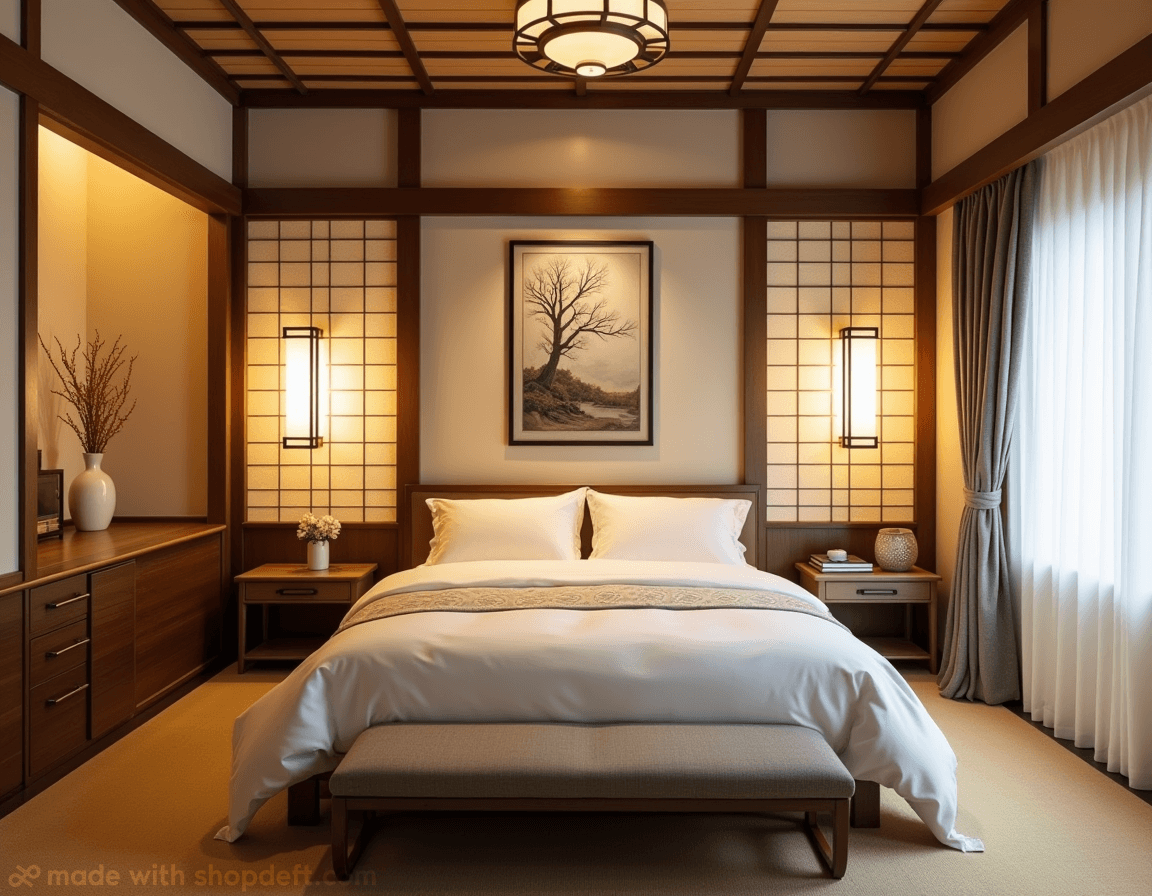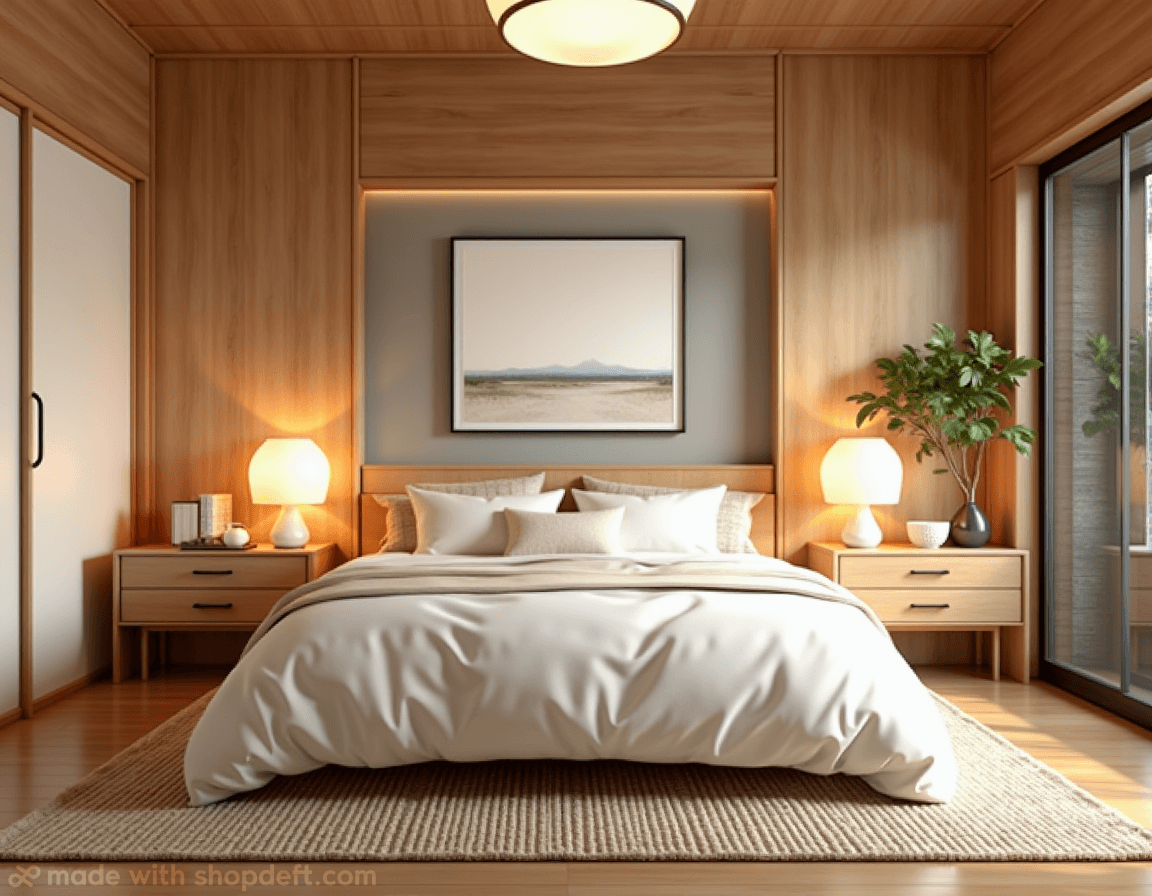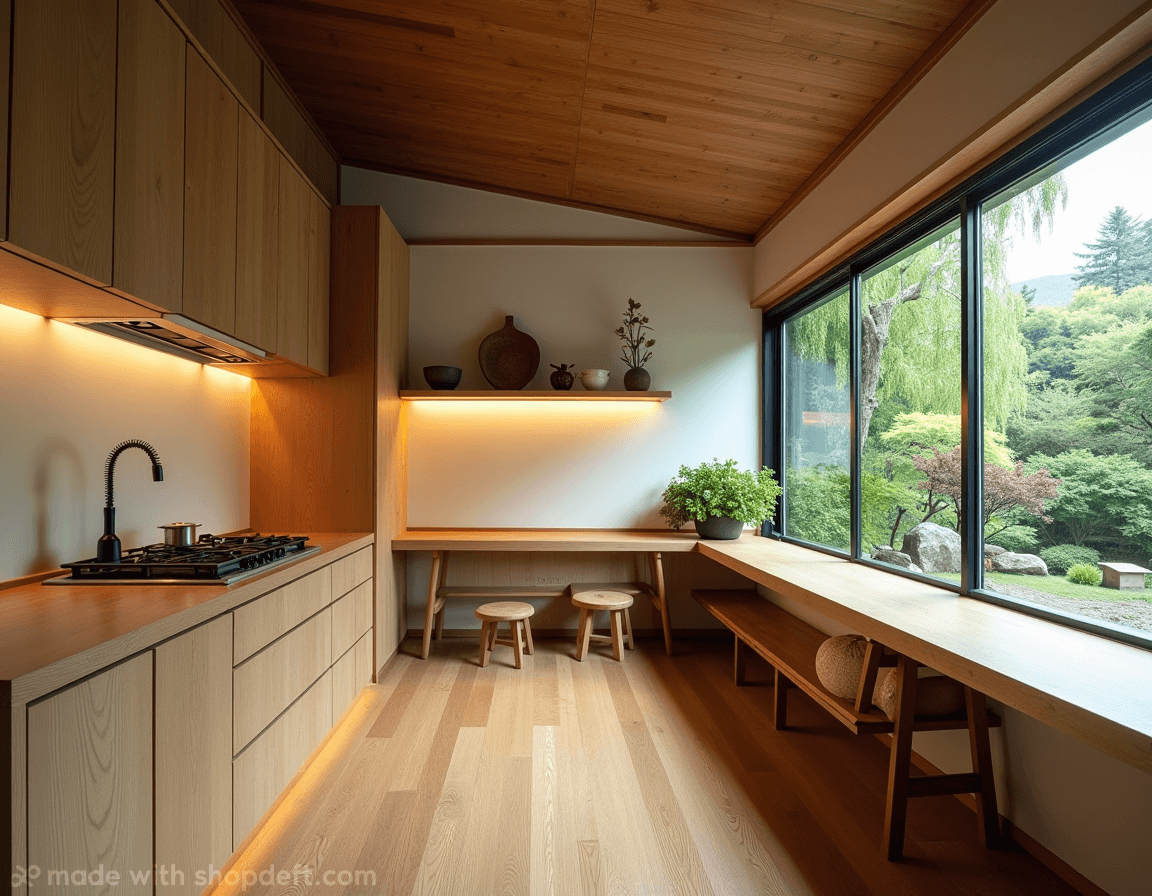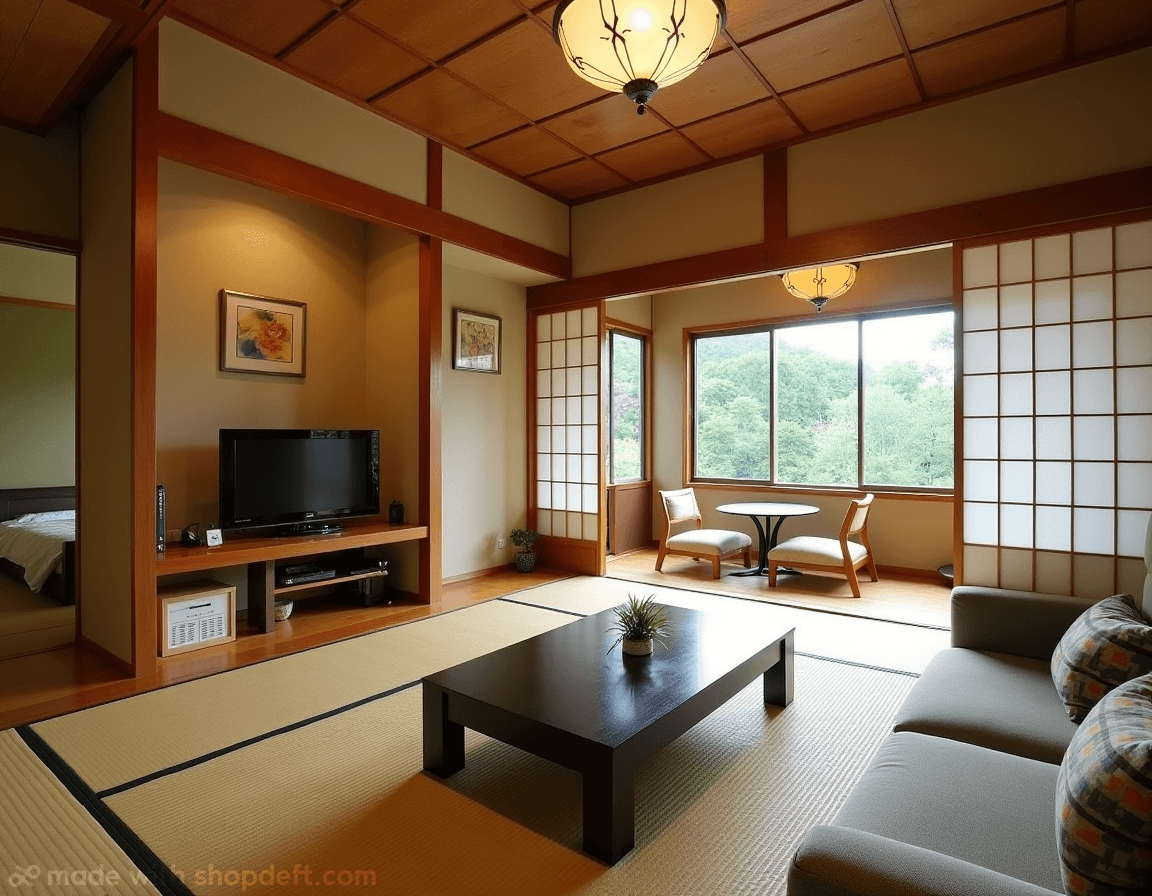Oct 9, 2024
•
Deft Team
Discover the elegant simplicity of Japanese style, from its core design principles to the practical ways to bring this balanced, minimalistic aesthetic into your home.
With simple lines, soft textures, and a neutral palette, Japanese-inspired spaces soothe the mind and inspire inner peace — everything you want to find when you step into your home.
Japanese interior design first gained traction in the mid-20th century and has steadily grown in popularity over recent years. As eco-conscious living picks up steam, natural materials commonly found in Japanese interiors, such as wood, bamboo, and stone, have caught the attention of those seeking to reconnect with nature.
While this traditional aesthetic may seem out of reach for more modern spaces, this guide is here to make it more accessible. Follow along for an in-depth introduction to Japanese interior design, including its philosophy, signature elements, and how virtual design tools can help you seamlessly capture this aesthetic in your home.
Explore the guiding principles that shape Japanese interior design
Simplicity, mindfulness, and practicality — the cornerstones of Japanese culture — are deeply embedded in every Japanese-styled space. The intent is to make us stop and appreciate the natural world with subtle choices to mimic the serenity you might find on a walk in the woods, offering few embellishments, gentle color choices, and a functional layout with plenty of breathing room.
Inspired by its timeless authenticity, many designers have reinterpreted the traditional Japanese style, creating new notable variations. Japandi — a versatile fusion of Japanese minimalism and Scandinavian comfort — has been especially popular in recent years.
Despite these modern takes, three key concepts remain rooted in every Japanese-inspired space.
The Principle of Zen
Imagine savoring a home-cooked meal at the edge of a low-sitting table. You can feel the soft tatami mat beneath you and hear the hum of evening air through the open windows, carrying in the scent of the outdoors. A moonlit glow filters through the shoji screens, and everything seems effortlessly at peace.
This is the harmonious vision of Zen every Japanese-inspired design aims to achieve.
The ancient principle of Zen draws inspiration from the surrounding world and is the foundation of all Japanese interior design. Shaped by Zen Buddhism’s teachings of mindful living, Zen spaces invite reflection and a desire to stay present in the moment.
The concept of “Ma”
Japanese design is deeply rooted in “Ma” — the notion of empty, or “negative,” space. The gaps “Ma” symbolizes are found in all aspects of life, reminding us that space is just as important as the elements that fill it.
In interior design, “Ma” encourages thoughtful furniture placement and careful selection, creating a subtle balance between objects and open space to cultivate a feeling of calm and peace. These layouts cut through the noise that comes with clutter and unnecessary furniture, fostering intentionality and mindfulness. Like a simple hand-painted scroll hanging behind a delicate flower arrangement, these minimalistic decorations take a “less is more” approach to make a softer statement in your space.
The philosophy of wabi-sabi
Wabi-sabi, the Japanese principle of finding beauty in imperfection, is at the heart of Japanese interior design. Every detail in a Japanese-inspired room honors the fleeting moments of joy and the quiet beauty that comes with age. It’s a philosophy that invites us to embrace the details that breathe life into a space.
The Japanese style does not shy away from cracks, stains, or other blemishes sometimes found in handmade or vintage pieces. While some may perceive natural elements like plants, stone, and wooden furniture as raw or unfinished, Japanese interiors accept these items just as they are — for their uneven rims or textures and the histories they may hold. This is the essence of wabi-sabi.

Meet the visionaries behind Japanese interior design
The fusion of authenticity and mindfulness in Japanese style has captivated millions across the globe, inspiring all kinds of modern takes. At the heart of its growing appeal are interior designers who continue to imbue their projects with its core elements:
Keiji Ashizawa: Founder of Keiji Ashizawa Design, Keiji Ashizawa promotes the principles of Japanese style through honest designs that capture the authenticity of every element – such as the smell of coffee beans in a coffee shop.
John Pawson: John Pawson’s design philosophy emphasizes natural materials and open layouts to emphasize a space’s personality. Through his minimalist approach and book “Minimum,” Pawson strips away the superfluous, finding peace and balance in every project.
Axel Vervoordt: An interior designer and art dealer, Axel Vervoordt pays homage to the Japanese concept of wabi-sabi by incorporating unrefined objects in projects of all kinds. His book, “Wabi Inspirations,” is a collection of interiors he has crafted to celebrate beauty in its most authentic form.
Bring serenity into your home with the 4 elements of Japanese style
Rooted in ancient Japanese tradition, Japanese interior design is more than an aesthetic choice for your home — it’s a lifestyle. Here’s how you can transform your home into a tranquil oasis using four traditional Japanese-style elements.
1. Turn your home into a Japanese-inspired haven with soft colors
Nuances of white, gray, and cream accompany every Japanese interior to visually expand the space, creating more room to breathe. Earthy tones like a muted green, warm browns, and subtle hints of burnt orange complement these primary shades to bring you closer to nature.
Incorporating this palette into your home can transform it into a Japanese-inspired dream. Start with an off-white or light gray base for your walls to create a serene backdrop that keeps the space bright and airy. Add accent colors through larger furniture, such as tatami mats, futons, and chabudai tables. For a finishing touch, layer in taupe and grassy greens reminiscent of the rich Japanese landscape through wall art and ceramic decorations.

2. Use natural materials for a calm ambiance
Bright wood like birch, cedar, and hickory is essential for every Japanese-styled home. When combined with other natural materials like clay, bamboo, and rice paper, these varied textures create a subtle movement throughout the space, inviting you to sit, absorb, and reflect the peaceful atmosphere.
Natural materials can elevate any living room by bringing depth and balance without overpowering the design. Cotton zabuton cushions invite you to relax with a hot cup of tea. And bamboo shades produce a softer natural light for a bright yet private space, while woodblock prints and stone vases add a timeless touch. All elements evoke a sense of tranquility and connection to the outdoors.
3. Design a practical space with simple, sleek furniture
Furniture with clean shapes transforms every room into a calm yet functional space. Think of floating shelves, chabudai dining tables, and handless drawers that keep your layout open, uncluttered, and practical, aligning with traditional Japanese design principles.
For example, Japanese-styled kitchens fuse functionality with minimalism, polished with smooth and practical furniture pieces. Compact cabinets with sliding doors keep the space clean, while wall-mounted shelves elevate the subtle aesthetic and ensure plenty of space. To complete the look, incorporate a low-profile countertop to establish a flow through the area without disrupting the atmosphere.

4. Create a soft, ambient glow with traditional shoji screens
Shoji screens made with wooden frames and translucent rice paper panels are the perfect way to create a soft ambiance and save space without compromising the minimalist look of your Japanese-inspired layout. They easily pair with your existing furniture as a decoration or a functional room divider, diffusing natural and artificial light to uplift any space.
Shoji screens’ versatility and calming effect make them the ideal addition to a Japanese-inspired bedroom. Use a shoji screen to create a separate reading nook to unwind or meditate at night. Add a bedside shoji lamp whose soft light will help clear your thoughts and relax the body. Even replace a traditional bed headboard or closet doors with delicate shoji screens to add texture while seamlessly elevating your overall design.
Live Your Japanese-Style Dream with Onton
Onton is the ultimate tool to discover and experiment with Japanese interior designs. Here’s how Onton can help you create simplicity, harmony, and function in your own home:
Onton Imagine
Onton Imagine brings your Japanese-inspired ideas to life in seconds. Explore natural materials, play with muted color palettes, and pick the perfect wabi-sabi furniture pieces to craft a serene Japanese-styled space.
Onton Search
Once you’ve honed your vision, Onton Search makes it easy to search and shop for the perfect Japanese-inspired furniture pieces. Drop an image of your desired tatami mat, shoji screen, and bonsai tree, or type keywords in the search field. Find the ideal blend of natural hues, soft shapes, and functionality for every decor item.
Onton Discover
Dive into the beauty of Japanese-inspired interior design with Onton Discover. Explore peaceful spaces filled with bamboo and wooden textures, “Ma” layouts, and earthy tones that foster balance and mindfulness.
Onton Concierge
Looking for expert guidance on your Japanese-inspired design journey? Get personalized advice from Onton Concierge, Onton’s AI-powered virtual assistant, to build harmonious spaces that reflect your vision and embrace natural beauty.
Try Onton for free today to turn your Japanese-inspired dream into a reality.

